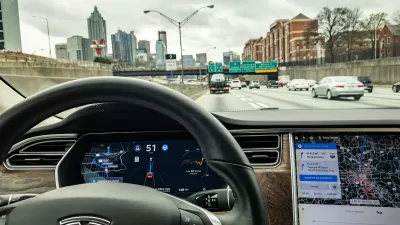While dozens of companies are following state-mandated regulations for autonomous vehicle testing, Tesla has managed to avoid the same rules. It's time for regulators to step in, according to the Los Angeles Times Editorial Board.

An editorial in the Los Angeles Times calls on state and federal authorities to step in to regulate Tesla's 'self-driving' vehicles, which have managed to evade DMV regulations during testing and deployment thanks to the company's claim that the "full self-driving mode" is "intended for use with a fully attentive driver who has their hands on the wheel." Meanwhile, Tesla's marketing and claims from its own CEO give consumers the impression that the cars can indeed drive themselves with little or no human intervention. To date, Teslas using the company's earlier Autopilot function have killed one person and injured 17 others.
While Tesla follows the Silicon Valley ethos of 'move fast and break things,' dozens of other companies experimenting with self-driving technology on California roads are following a reasonable set of rules. They must have a trained and certified test driver behind the wheel and send the DMV regular reports on crashes as well as incidents in which the human driver had to take over to avoid a crash.
According to a California DMV spokesperson, "Tesla informed the agency that 'Full Self-Driving' cars are in a different category, known as 'level 2,' that incorporates more common driver-assistance tools like automatic steering and cruise control but still require attention from a human driver."
The op-ed argues that the company can't have it both ways: Tesla's vehicles should be forced to follow the same rules as everyone else before more people are injured or killed.
FULL STORY: Editorial: Slam the brakes on Tesla’s self-driving madness

Alabama: Trump Terminates Settlements for Black Communities Harmed By Raw Sewage
Trump deemed the landmark civil rights agreement “illegal DEI and environmental justice policy.”

Planetizen Federal Action Tracker
A weekly monitor of how Trump’s orders and actions are impacting planners and planning in America.

How Atlanta Built 7,000 Housing Units in 3 Years
The city’s comprehensive, neighborhood-focused housing strategy focuses on identifying properties and land that can be repurposed for housing and encouraging development in underserved neighborhoods.

In Both Crashes and Crime, Public Transportation is Far Safer than Driving
Contrary to popular assumptions, public transportation has far lower crash and crime rates than automobile travel. For safer communities, improve and encourage transit travel.

Report: Zoning Reforms Should Complement Nashville’s Ambitious Transit Plan
Without reform, restrictive zoning codes will limit the impact of the city’s planned transit expansion and could exclude some of the residents who depend on transit the most.

Judge Orders Release of Frozen IRA, IIJA Funding
The decision is a victory for environmental groups who charged that freezing funds for critical infrastructure and disaster response programs caused “real and irreparable harm” to communities.
Urban Design for Planners 1: Software Tools
This six-course series explores essential urban design concepts using open source software and equips planners with the tools they need to participate fully in the urban design process.
Planning for Universal Design
Learn the tools for implementing Universal Design in planning regulations.
Jessamine County Fiscal Court
Caltrans
Institute for Housing and Urban Development Studies (IHS)
City of Grandview
Harvard GSD Executive Education
Toledo-Lucas County Plan Commissions
Salt Lake City
NYU Wagner Graduate School of Public Service





























